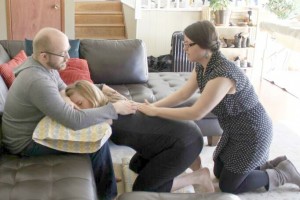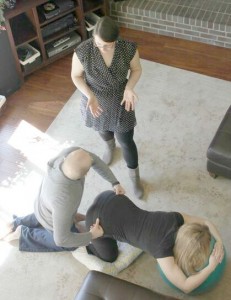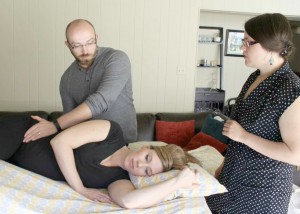- mamajanemassage
- Aug, 09, 2015
- Birth Doula, Birth Massage, Birth Work, Mama Jane Massage, Pregnancy
- Comments Off on Teaching Labor Massage to Doula Clients and Birth Partners
By Liz Green, CD (toLabor), LMT, CR
The Gate Control Theory tells us that touch can override pain sensations in the body – sensations from touch reach the central nervous system faster than pain sensations. We instinctively hold an area when we injure it to calm pain. Massage is a naturally effective technique to use during birth to soften and relax the body and diminish pain sensations. Touch stimulates the parasympathetic nervous system, which counteracts stress, fear and pain.
Between contractions, touch that is calm, soothing and relaxing can help a birthing client to rest and re-energize for the contractions ahead. Kneading or compressions on the gluteal area, hips and legs can help to soften and open the pelvis, making space for baby to move down. Firm, sustained pressure on the sacrum and hips can diminish the intensity of a baby moving through the birth canal. Birth works more effectively when clients are in a space free from fear and tension. Stress hormones can sometimes cause labor to slow down, stall out or even feel more painful – massage is known to decrease stress levels, thus it is a powerful tool to create and maintain a low-stress environment for birth.
As a massage therapist and doula I always teach the client’s partner birth massage during one of our prenatal appointments. If the primary birth partner is also the client’s romantic partner, I try to tap into their intuitive knowledge of their partner. They know more than anyone how the client likes to be touched – how soft or firm, fast or slow, the low back or the shoulders, the feet or hands. Having the partner massage the client relaxes both of them, creates a bonding experience in a time of uncertainty, and gives partners an important task to do. Touch from a significant other produces oxytocin, the love hormone, which simultaneously makes the client feel loved, comforted and safe, while encouraging baby to enter the world. Since oxytocin is the hormone that is released through loving touch, sex, orgasms and is also the hormone that causes contractions, it is true what I have heard many midwives say: the energy that gets the baby in, gets the baby out.
Tips for the birth partner:
- Check in with your body – release tension from your body by doing a few deep breaths and grounding yourself before you touch your partner – whatever tension you feel in your body, they will feel too; try to keep your shoulders relaxed down your back and your hands strong but soft.
- Additionally, maintaining good body mechanics will save your own body from soreness and exhaustion. When providing standing support, sink into your knees so your back doesn’t take all the weight. When on your knees, put one foot flat on the ground to provide stability and leverage for massage strokes. When possible, use your body weight to sink into a muscle instead of using just your upper body strength. Take breaks and stretch at least once an hour.
- Massage with the rhythm of your breath – long, slow strokes feel better than fast superficial touch. Keep your breath slow and deep for slow deep massage strokes. Birth can be slow and boring – birth massage has no time limit, so massaging fast won’t make it end sooner. 🙂
- Listen to your intuition – where does your partner usually like to be touched? With what kind of pressure? Are they wincing in pain during your massage or moaning with gratitude? Birthing clients aren’t always able to give verbal feedback, so pay attention to their body language.
- If your partner decides to get an epidural, relaxation techniques are still great tools to help them maximize their resting time. Focus on their scalp, neck, shoulders and hands.










